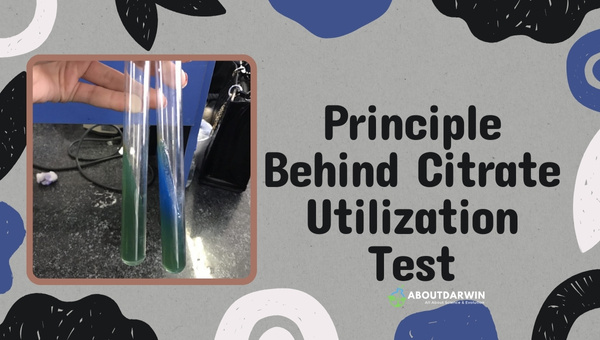Physical Address
304 North Cardinal St.
Dorchester Center, MA 02124
The citrate utilization test is a fundamental procedure in microbiology, designed to assess an organism’s ability to utilize citrate as its sole carbon source. This test plays a pivotal role in the identification and differentiation of various bacterial species, particularly within the Enterobacteriaceae family.
By understanding the results of the citrate test, microbiologists can gain insights into metabolic capabilities that are crucial for effective diagnosis and treatment.
Prepare to explore how this simple yet powerful test can reveal the hidden potential of microorganisms in clinical and environmental settings.
Contents
The citrate utilization test, also known as the citrate test in microbiology, evaluates whether an organism can use sodium citrate as its only carbon source and inorganic ammonium salts as a nitrogen source.
The medium typically used for this test is Simmons citrate agar, which contains sodium citrate and a pH indicator, such as bromothymol blue, that changes color based on the pH level.
The citrate utilization test is part of the IMViC series (Indole, Methyl Red, Voges-Proskauer, and Citrate tests), which are essential for identifying Gram-negative bacilli.
It helps differentiate between coliforms and fecal coliforms, providing crucial information about bacterial metabolism and ecological interactions.
The citrate utilization test is designed to differentiate bacterial species based on their ability to use citrate as the sole carbon source. This test is vital for identifying various bacteria and understanding their metabolic capabilities.

The Citrate Utilization test attempts to identify and differentiate different types of bacteria based on their ability to use citrate as a sole carbon source.
The principle behind the citrate test revolves around the bacterium’s ability to metabolize citrate. Specific bacteria possess an enzyme called citrase, which enables them to convert citrate into energy.
When these bacteria grow on a medium containing sodium citrate, they produce alkaline byproducts, leading to a change in pH.
This change is indicated by a color shift in the medium, typically from green to blue, signaling the presence of citrate-utilizing bacteria.
Simmons Citrate Agar is the primary medium used in this test, containing:
When bacteria metabolize citrate, they produce ammonia and sodium carbonate, raising the pH and causing the bromothymol blue indicator to turn blue at alkaline levels (above pH 7.6).
Preparation Process To prepare Simmons Citrate Agar:
This prepared medium allows for differentiation based on the bacteria’s ability to utilize sodium citrate. A color change from green (neutral) to blue (alkaline) indicates a positive result, confirming that the bacteria can metabolize citrate effectively.
Also Read: Sabouraud Dextrose Agar (SDA): Composition, Uses, and More
The citrate test procedure is a crucial method in microbiology for assessing the ability of bacteria to utilize citrate as their sole carbon source.
This test is particularly significant for differentiating members of the Enterobacteriaceae family. By observing growth and color changes in the medium, researchers can determine whether specific bacteria can metabolize citrate.
Preparation of Simmons Citrate Agar: Prepare Simmons citrate agar, which contains sodium citrate as the sole carbon source and ammonium salts as the nitrogen source. The medium composition includes:
| Ingredient | Amount (g/L) |
|---|---|
| Ammonium hydrogen phosphate (NH₄H₂PO₄) | 1 |
| Dipotassium phosphate (K₂HPO₄) | 1 |
| Sodium chloride (NaCl) | 5 |
| Sodium citrate (C₆H₅Na₃O₇) | 2 |
| Magnesium sulfate (MgSO₄) | 0.20 |
| Bromothymol blue | 0.08 |
| Agar | 15 |
| Distilled water | 1 L |
Inoculation:
Incubation:
Observation:
Interpretation of Results:
This citrate test procedure is essential for identifying and differentiating bacterial species based on their metabolic capabilities, particularly among members of the Enterobacteriaceae family, such as Klebsiella and Escherichia species.
Also Read: Identification and Biochemical Testing of Streptococcus pyogenes
The test is used to differentiate between bacteria based on their ability to use citrate as their only source of carbon.
No, not all types of bacteria can utilize citrate as a sole carbon source. Only certain species exhibit this trait.
Yes, the test is quite accurate and reliable for differentiating species such as those within the Enterobacteriaceae family.
Yes, standard laboratory procedures such as wearing lab coats, gloves, and eye protection should be followed when handling bacterial cultures.
The citrate utilization test plays a pivotal role in microbiology by distinguishing bacterial species based on their ability to utilize citrate as a carbon source.
This test is especially significant for identifying members of the Enterobacteriaceae family, aiding in accurate classification and understanding of pathogenic potential.
By leveraging the insights gained from the citrate test, microbiologists can enhance diagnostic accuracy and improve treatment strategies, ultimately contributing to better patient outcomes and advancing our knowledge of microbial metabolism.